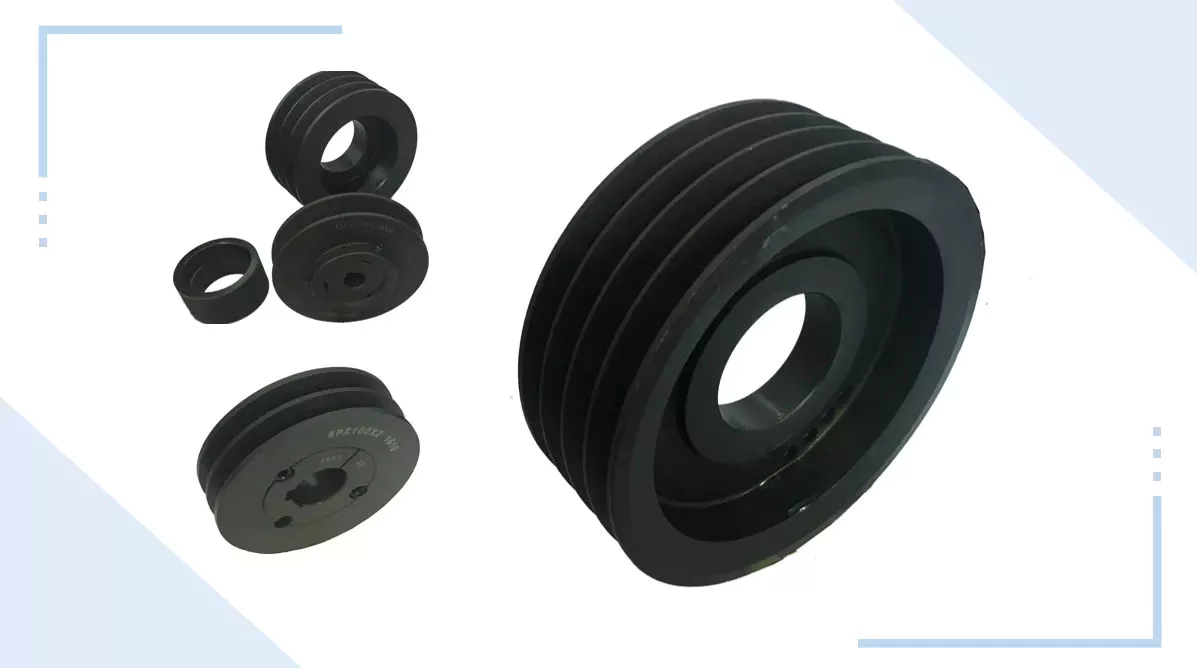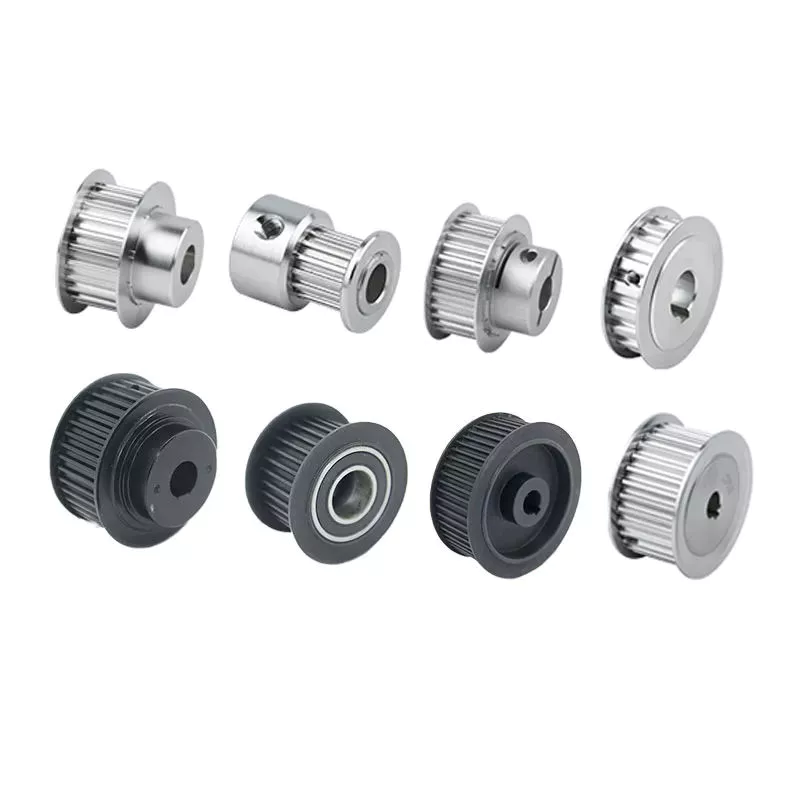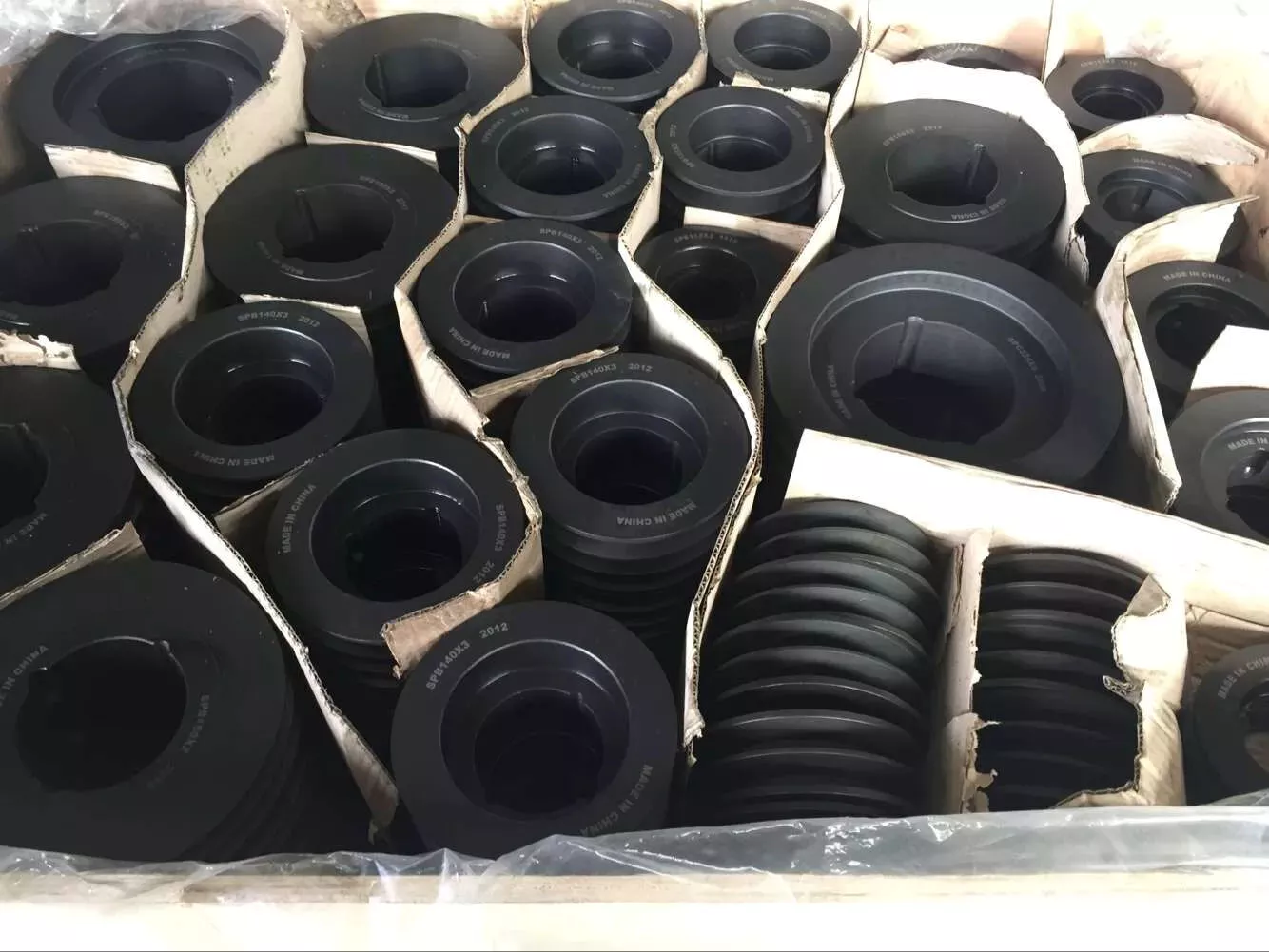Product Description
Solution Description
Tail pulley / Snub pulley / Take up pulley for Bulk content belt conveyor
| Description | Fabrication Solutions flat belt idler pulley for belt conveyor |
| Software | Utilized in electric powered electricity, metallurgy,mine,coal, cement,metal,chemical, port, hydroelectric energy and CZPT industries |
| Pipe/Tube/Shell | 1)Content:Q235 Metal two)Diameter:219mm-3000mm 3)Length:500mm-5000mm,depends on the belt width of the conveyor |
| Shaft/Axis | Material:#45 Steel |
| Bearing | Large roving crack, deep groove ball with double sealing |
| Welding | Pipe and bearing housing with computerized welding |
| Surface area | Smooth steel shade floor, rubber lagging surface area |
| Colour | Crimson,inexperienced,blue or as demand |
| Provider life | More than 30,000 several hours |
| Normal | GB,ISO,DIN,CEMA,JIS |
Comprehensive Pictures
Merchandise Parameters
Our Pulley Functions:
| Conveyor Pulley Test | one. All butt welds shall be entire Penetration two. All welds to be entire seal welds to avoid rust three. Shell seam welds are submerged arc (Observed) four. Involves stress relieving of shell prior to machining 5. Ultrasonic testing of all shafts six. Drillings for Temperature probe / vibration investigation unit seven. Take away all butts and sharp edges |
| Conveyor Pulley Shaft Selection | The major cause of conveyor pulley failure is abnormal shaft deflection. The Conveyor Pulleys – ZheJiang HSCD Engineering office can perform Pressure Examination and Finite Aspect Investigation to maximize your conveyor pulley functionality. |
| Conveyor Pulley Shell Material | Q345B Carbon Metal GR350 Carbon Steel ANSI 4140 Alloy Metal ASTM A514B Stainless Metal |
| Bearing House | SKF/NSK/ /HRB/LYC, as customer ask for. |
| Conveyor Pulley Lagging | Plain rubber lagging, Herringbone and CZPT grooves are all available . Hot Vulcanised Durometer . Hardness 50-55-sixty five Shore A, M Grade . Oil Resistant, Heat Resistant FRAS |
| Comprising | •Drive pulley, Head pulley and Tail Pulleys •Take-Up Pulleys, •Snub pulley & Bend Pulleys •Self Cleansing Spiral CZPT pulley & Drum Pulleys |
| Significant positive aspects | • The thick pulley shell absorbs more stress. • The big crown angle provides excellent belt tracking abilities. • Accurate concentric machining provides: • maximum get in touch with with the belt, • regular belt content material discharge, • considerably less deflection of shaft, • considerably less anxiety on the bearings |
| Offered Conveyor Pulley Designs |
•Liveshaft or Deadshaft sorts. •Flat or crowned shell. •Taconite, labyrinth or speciality seals. •Oil or grease lubricated. •Self centering or lower strain lock factor designs. |
Certifications
Packaging & Shipping
Following Income Services
In addition to the structural drum pulley benefits, we offer extra services with each conveyor pulley get:
• Engineering abilities.(We can engineer and customized develop pulleys to your needs making use of computer software tools such as Finite Factor Evaluation).
• In- property made hubs and shafts.
• This assures consistency and compatibility of components of the pulley.
• Reinforced Mine Responsibility pulleys are available.
• In- residence assembly of comprehensive pulley unit including: bushing, shaft, bearings and equipment box.
• Dynamic or Static balancing on request.
In addition to we can manufacture the conveyor drum pulley according to the buyers’ requirements
What kinds of Conveyor Pulleys we can manufacture:
·Conveyor head pulley, Conveyor generate pulley, Conveyor bend pulley, Conveyor Tail Pulley
·Conveyor rigidity pulley, Conveyor snub Pulley, Conveyor CZPT Pulley, Conveyor get up Pulley and so on
| Material: | Carbon Steel |
|---|---|
| Surface Treatment: | Rubber Lagging |
| Motor Type: | Without Motor |
| Installation: | with Reducer |
| Bearing: | 3520 |
| Rubber Lagging: | 10-20 mm |
###
| Customization: |
Available
|
|---|
###
| Description | Fabrication Services flat belt idler pulley for belt conveyor |
| Application | Used in electric power, metallurgy,mine,coal, cement,steel,chemical, port, hydroelectric power and grain industries |
| Pipe/Tube/Shell | 1)Material:Q235 Steel 2)Diameter:219mm-3000mm 3)Length:500mm-5000mm,depends on the belt width of the conveyor |
| Shaft/Axis | Material:#45 Steel |
| Bearing | Big roving crack, deep groove ball with double sealing |
| Welding | Pipe and bearing housing with automatic welding |
| Surface | Smooth steel color surface, rubber lagging surface |
| Color | Red,green,blue or as require |
| Service life | More than 30,000 hours |
| Standard | GB,ISO,DIN,CEMA,JIS |
###
| Conveyor Pulley Test | 1. All butt welds shall be full Penetration 2. All welds to be full seal welds to prevent rust 3. Shell seam welds are submerged arc (SAW) 4. Includes stress relieving of shell prior to machining 5. Ultrasonic testing of all shafts 6. Drillings for Temperature probe / vibration analysis device 7. Remove all butts and sharp edges |
| Conveyor Pulley Shaft Selection | The major cause of conveyor pulley failure is excessive shaft deflection. The Conveyor Pulleys – Beijing HSCD Engineering department can perform Stress Analysis and Finite Element Analysis to maximize your conveyor pulley performance. |
| Conveyor Pulley Shell Material | Q345B Carbon Steel GR350 Carbon Steel ANSI 4140 Alloy Steel ASTM A514B Stainless Steel |
| Bearing House | SKF/NSK/ /HRB/LYC, as customer request. |
| Conveyor Pulley Lagging | Plain rubber lagging, Herringbone and Diamond grooves are all available . Hot Vulcanised Durometer . Hardness 50-55-65 Shore A, M Grade . Oil Resistant, Heat Resistant FRAS |
| Comprising | •Drive pulley, Head pulley and Tail Pulleys •Take-Up Pulleys, •Snub pulley & Bend Pulleys •Self Cleaning Spiral Wing pulley & Drum Pulleys |
| Significant advantages | • The thick pulley shell absorbs more stress. • The large crown angle provides superior belt tracking capabilities. • True concentric machining provides: • maximum contact with the belt, • consistent belt content discharge, • less deflection of shaft, • less stress on the bearings |
| Available Conveyor Pulley Designs |
•Liveshaft or Deadshaft types. •Flat or crowned shell. •Taconite, labyrinth or speciality seals. •Oil or grease lubricated. •Self centering or low pressure lock element designs. |
| Material: | Carbon Steel |
|---|---|
| Surface Treatment: | Rubber Lagging |
| Motor Type: | Without Motor |
| Installation: | with Reducer |
| Bearing: | 3520 |
| Rubber Lagging: | 10-20 mm |
###
| Customization: |
Available
|
|---|
###
| Description | Fabrication Services flat belt idler pulley for belt conveyor |
| Application | Used in electric power, metallurgy,mine,coal, cement,steel,chemical, port, hydroelectric power and grain industries |
| Pipe/Tube/Shell | 1)Material:Q235 Steel 2)Diameter:219mm-3000mm 3)Length:500mm-5000mm,depends on the belt width of the conveyor |
| Shaft/Axis | Material:#45 Steel |
| Bearing | Big roving crack, deep groove ball with double sealing |
| Welding | Pipe and bearing housing with automatic welding |
| Surface | Smooth steel color surface, rubber lagging surface |
| Color | Red,green,blue or as require |
| Service life | More than 30,000 hours |
| Standard | GB,ISO,DIN,CEMA,JIS |
###
| Conveyor Pulley Test | 1. All butt welds shall be full Penetration 2. All welds to be full seal welds to prevent rust 3. Shell seam welds are submerged arc (SAW) 4. Includes stress relieving of shell prior to machining 5. Ultrasonic testing of all shafts 6. Drillings for Temperature probe / vibration analysis device 7. Remove all butts and sharp edges |
| Conveyor Pulley Shaft Selection | The major cause of conveyor pulley failure is excessive shaft deflection. The Conveyor Pulleys – Beijing HSCD Engineering department can perform Stress Analysis and Finite Element Analysis to maximize your conveyor pulley performance. |
| Conveyor Pulley Shell Material | Q345B Carbon Steel GR350 Carbon Steel ANSI 4140 Alloy Steel ASTM A514B Stainless Steel |
| Bearing House | SKF/NSK/ /HRB/LYC, as customer request. |
| Conveyor Pulley Lagging | Plain rubber lagging, Herringbone and Diamond grooves are all available . Hot Vulcanised Durometer . Hardness 50-55-65 Shore A, M Grade . Oil Resistant, Heat Resistant FRAS |
| Comprising | •Drive pulley, Head pulley and Tail Pulleys •Take-Up Pulleys, •Snub pulley & Bend Pulleys •Self Cleaning Spiral Wing pulley & Drum Pulleys |
| Significant advantages | • The thick pulley shell absorbs more stress. • The large crown angle provides superior belt tracking capabilities. • True concentric machining provides: • maximum contact with the belt, • consistent belt content discharge, • less deflection of shaft, • less stress on the bearings |
| Available Conveyor Pulley Designs |
•Liveshaft or Deadshaft types. •Flat or crowned shell. •Taconite, labyrinth or speciality seals. •Oil or grease lubricated. •Self centering or low pressure lock element designs. |
Types of Pulley Systems
If you’ve ever tried to lift a pail of water, you’ve probably seen the pulley system in action. Pulleys are extremely useful tools for everything from household appliances to heavy industrial machinery. Different kinds of pulley systems are classified according to their amount of motion. Some types have fixed axes, while others have movable axes. Some common uses of pulleys are listed below.
two-wheel pulley
Pulleys are complex structures with thin-walled and thick-walled sections. Therefore, they require specific forging designs. The tool concept for the production of pulleys is shown in Figure 11.6. Using the generated tool, the pulley can be forged into different shapes. Process parameters must be optimized based on material, surface quality and metallographic analysis.
Pulleys are wheels mounted on shafts. Its main function is to assist the movement of heavy objects. A single-wheel pulley can change the direction of the force, enabling a person to pull heavy objects. A dual-wheel pulley distributes the weight evenly across both wheels, allowing it to lift the same weight with half the effort.
The mechanical advantage of a two-wheel pulley is that it reduces the force required by about half. A 100 kg object can be lifted with a force of 500 Newtons. The mechanical advantage of a pulley with two wheels is twice that of a single-wheel pulley. However, care should always be taken when using two-wheel pulleys.
Two-wheel pulleys can be fixed or movable. A single wheel pulley can only change direction when the load is placed on one side of the wheel. Two-wheel pulleys change direction when lifting a load, requiring half the force. Live wheels are better for heavier loads. The movable pulley can be adjusted with the load, and the load distribution is more uniform. Active pulleys can be used with single-rope or two-wheel pulleys.
A pulley system with two wheels is called a compound pulley. This type of pulley system has a complex design that reduces the force required to move the load. Two-wheel pulleys are common in industrial and construction environments. These pulleys require a lot of space to install and operate. Additionally, they require regular maintenance to avoid wear and tear.
composite pulley
Compound pulleys are used to increase lift. One fixed pulley is attached to the overhead while the other fixed pulley is attached to the load. This setup minimizes the force required to lift weights, allowing you to lift heavier weights. There are several different types of compound pulleys, each with their own strengths and weaknesses. Below are some examples of their application. Some of the most common are listed below.
Composite pulleys are usually made from two different types of wheels. The first one is fixed and secure. The second type, movable, is attached to something that moves. The third type, compound pulley, is a combination of a movable pulley and a fixed pulley. Below are three types of comparisons. The table below compares them and explains their advantages and disadvantages. Composite pulleys are the most versatile of the three.
The number of sheave segments that make up the composite sheave system increases the mechanical advantage of the system. Each segment adds one percent of the total weight, and the ideal mechanical advantage is two or more. So a compound pulley with four segments will lift three-quarters of the weight. This is because the force applied to the load is multiplied by four. The result is a better boost.
While composite pulleys have many uses, they are most commonly used on larger sailboats. These pulleys work by changing the direction of the control wire or by changing the mechanical force of the rope. They also make it easier to lift heavier objects. Composite pulleys are more expensive than simple pulleys, so consider your needs before buying. The advantages of composite pulleys outweigh the disadvantages.
A basic compound pulley is a device consisting of two wheels with fixed points. Ropes are looped around the wheels and are used to lift heavy objects. When you pull on the rope, the rope pulls the two wheels closer together. Serious injury could result if this equipment is installed incorrectly. Never exceed the lifting capacity of pulleys and other safety devices that may be attached. When using pulleys, be sure to follow the instructions on the mounting hardware to avoid accidents.
Fixed pulley
Moving pulleys and fixed pulleys are different types of mechanical devices. The movable pulley moves with the object it is used to lift. Because it attaches to the object it is used to lift, it is great for lifting heavy objects. These devices are used in construction cranes and multipurpose elevators. There are many different types of pulleys, and their uses vary widely. Below is a brief overview of these devices.
The simplest pulley set consists of a wheel that is mounted on the ceiling. A rope is attached at one end and a person pulls at the other end. The rope is strong enough to keep a person standing while lifting weights. It takes about 200 Newtons of force to lift a 20 kg weight. In contrast, a movable pulley requires a force of 1000N, which makes it easier to lift heavy objects.
Fixed pulleys are another common lifting device. They work by using ropes and slotted wheels attached to the object to be lifted. These devices are convenient to use because they are easy to set up. Moving the scroll wheel doesn’t change direction, so it’s easier to move objects without putting too much pressure on the back. Unlike a moving rope, a moving object will feel much lighter than its actual weight.
Fixed pulleys are widely used in construction and agriculture. Fixed pulleys can help lift supplies and equipment from scaffolding. These items are often heavy and difficult to lift directly. Fixed pulleys at the top of the scaffolding will allow people at the bottom to lift objects more easily. As a result, those at the bottom are less stressed and more productive. Fixed pulleys will save time and money compared to moving ropes.
Composite pulleys combine fixed and movable pulleys to increase the power of movement. A compound pulley system uses both types of pulleys and enables a person to change direction by reversing the direction of a force. The compound pulley system will save time and effort as the user only has to put in half the effort. Unlike moving ropes, composite pulleys are easy to adjust and are the most versatile system on the market.
Blocks and tackles
A pulley block system is a rope hoist that uses a set of pulleys mounted on a frame. The blocks are arranged in a row, and the threaded rope is called a pulley. Pulley systems help amplify the tension of the rope and are common in sailboats, cranes and drilling rigs. However, these systems are not without drawbacks.
The pulley pulley system can be equipped with as many pulleys as required. This method allows a person to lift heavy objects. The pulley block system can contain the required number of pulleys to achieve the desired height. The main disadvantage of pulley systems is that they create a lot of friction on the pulley shaft.
Pulley systems use two types of pulleys. A movable pulley is attached to the load, allowing it to move with the load. On the other hand, fixed pulleys are fixed on fixed points. Therefore, a pulley block system may consist of multiple pulleys mounted on a shaft. For example, the two pulleys attached to the shaft each have their own mechanical advantages.
Several types of tackle systems have been developed in recent centuries. The most basic is the gun mount, which uses two pulleys to lift the load. The mechanical advantage of such a system is two to three times the distance required by the rope to move the load. Depending on how they’re assembled, the system can lift 400 pounds with 80 or 100 pounds of force.
Another type of pulley is a combination of multiple wheels. The wheels on pulleys are supported by a housing or frame. The chain is attached to the pulley, and the rope is pulled to lift it. A combined pulley system will have multiple wheels. As the load increases, the force on the pulley also increases. This approach is generally more expensive than intercept and intercept systems.
editor by czh 2022-12-25




